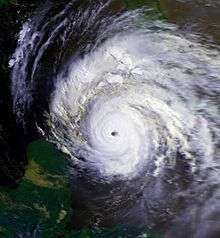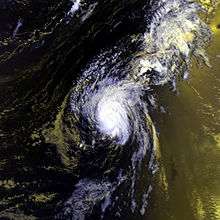NOAA-6
| Names | NOAA-A | ||||||||||
|---|---|---|---|---|---|---|---|---|---|---|---|
| Mission type |
Meteorology Earth observation | ||||||||||
| Operator | NOAA | ||||||||||
| COSPAR ID | 1979-057A | ||||||||||
| SATCAT no. | 11416 | ||||||||||
| Mission duration |
Planned: 2 years Final: 7 years, 9 months, 3 days | ||||||||||
| Spacecraft properties | |||||||||||
| Bus | TIROS-N[1] | ||||||||||
| Manufacturer | RCA Astro Electronics[2] | ||||||||||
| Launch mass | 723 kg (1,594 lb)[1] | ||||||||||
| Start of mission | |||||||||||
| Launch date | 27 June 1979, 15:51:59 UTC[3] | ||||||||||
| Rocket | Atlas F 25F[2] | ||||||||||
| Launch site | Vandenberg SLC-3W[2] | ||||||||||
| End of mission | |||||||||||
| Disposal | Decommissioned | ||||||||||
| Deactivated | 31 March 1987[4] | ||||||||||
| Orbital parameters | |||||||||||
| Reference system | Geocentric | ||||||||||
| Regime | Sun-synchronous | ||||||||||
| Perigee | 833 km (518 mi) | ||||||||||
| Apogee | 833 km (518 mi) | ||||||||||
| Inclination | 98.7 | ||||||||||
| Period | 101.5 minutes | ||||||||||
| Epoch | 27 June 1979, 11:52:00 UTC[3] | ||||||||||
| |||||||||||
|
TIROS-N | |||||||||||
NOAA-6, designated NOAA-A before launch, was a weather satellite operated by NOAA as part of its National Operational Environmental Satellite System.[5] It was launched into a Sun-synchronous orbit by NASA aboard an Atlas F launch vehicle on 27 June 1979 from Vandenberg Air Force Base SLC-3W.[2] Based on the experimental TIROS-N satellite,[2] it performed monitoring of ice and snow cover, agriculture, oceanography, volcanism, ozone and the space environment, in addition to its regular meteorological observations.[6]
Its instruments included the Advanced Very High Resolution Radiometer (AVHRR/1) for global cloud cover observations, the TIROS Operational Vertical Sounder (TOVS) suite for atmospheric temperature and water vapor profiling, the Space Environment Monitor (SEM) for measuring proton and electron fluxes, and the Data Collection and Platform Location System (DCPLS) for relaying data from balloons and ocean buoys. The TOVS suite consists of three subsystems: the High Resolution Infrared Radiation Sounder 2 (HIRS/2), the Stratospheric Sounding Unit (SSU), and the Microwave Sounding Unit (MSU).[2][7]
The HIRS/2 instrument failed on 19 September 1983,[4] and the spacecraft was placed in reserve in early 1984 as NOAA prioritized operations of NOAA-7 and NOAA-8.[5] It was returned to operational status after NOAA-8 failed in June 1984, and continued to return data until its decommissioning on 31 March 1987.[4]
Gallery
 Hurricane Allen in the Yucatán Channel near peak intensity
Hurricane Allen in the Yucatán Channel near peak intensity
7 August 1980 Hurricane Bonnie
Hurricane Bonnie
16 August 1980 Hurricane Charley
Hurricane Charley
23 August 1980 Hurricane Georges
Hurricane Georges
8 September 1980 Hurricane Frances
Hurricane Frances
9 September 1980
See also
References
- 1 2 "Tiros N". Encyclopedia Astronautica. Retrieved 15 January 2017.
- 1 2 3 4 5 6 "TIROS-N, NOAA 6, B, 7". Gunter's Space Page. Retrieved 15 January 2017.
- 1 2 "NOAA 6: Trajectory Details". National Space Science Data Center. NASA. Retrieved 15 January 2017.
- 1 2 3 "NOAA Heritage". Polar Operational Environmental Satellites. NASA. Retrieved 15 January 2017.
- 1 2 "NOAA 6: Details". National Space Science Data Center. NASA. Retrieved 15 January 2017.
- ↑ "CEOS EO Handbook - Mission Summary - NOAA-6". CEOS Database. European Space Agency. Retrieved 15 January 2017.
- ↑ "NOAA 6: Experiments". National Space Science Data Center. NASA. Retrieved 15 January 2017.
External links
![]()
